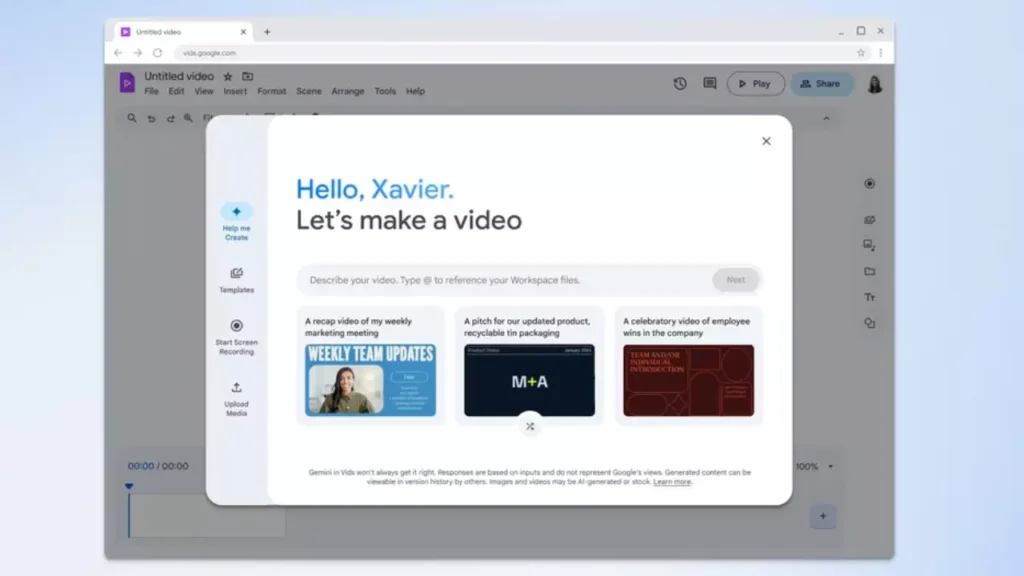Google’s AI Labs have found that their video generation models are advancing at an incredible pace. The artificial intelligence departments at the search engine giant are working to further the technology of creating AI soundtracks for videos and have teased the “next major step forward” in an update.
In a recent blog post, Google AI Labs highlighted the rapid progress of video generation models. However, they noted a significant limitation: many current systems can only generate silent videos. Addressing this gap, they revealed their focus on developing synchronized audiovisual generation capabilities. The post stated, “Video generation models are advancing at an incredible pace, but many current systems can only generate silent output. One of the next major steps toward bringing generated movies to life is creating soundtracks for these silent videos.”
To tackle this challenge, Google AI Labs has been working on their video-to-audio (V2A) technology. This innovative system is designed to make synchronized audiovisual generation possible by combining video pixels with natural language text prompts. This integration allows for the creation of rich soundscapes that perfectly match the on-screen action. The blog post elaborated, “Today, we’re sharing progress on our video-to-audio (V2A) technology, which makes synchronized audiovisual generation possible. V2A combines video pixels with natural language text prompts to generate rich soundscapes for the on-screen action.”
The potential applications of V2A technology are vast. It can be paired with video generation models like Veo to create dramatic scores, realistic sound effects, or dialogue that aligns with the characters and tone of a video. Moreover, V2A is not limited to newly generated videos. It can also generate soundtracks for traditional footage, including archival material, silent films, and more. This capability opens up a wider range of creative opportunities, enabling creators to breathe new life into old footage. The post emphasized, “Our V2A technology is pairable with video generation models like Veo to create shots with a dramatic score, realistic sound effects or dialogue that matches the characters and tone of a video. It can also generate soundtracks for a range of traditional footage, including archival material, silent films and more — opening a wider range of creative opportunities.”
A notable feature of V2A technology is its ability to generate an unlimited number of soundtracks for any video input. This flexibility allows users to experiment with different audio outputs rapidly and choose the best match for their video. Users have the option to define ‘positive prompts’ to guide the generated output towards desired sounds or ‘negative prompts’ to steer it away from undesired sounds. This level of control empowers creators to tailor the audio experience precisely to their needs. The blog post highlighted, “Importantly, V2A can generate an unlimited number of soundtracks for any video input. Optionally, a ‘positive prompt’ can be defined to guide the generated output toward desired sounds, or a ‘negative prompt’ to guide it away from undesired sounds. This flexibility gives users more control over V2A’s audio output, making it possible to rapidly experiment with different audio outputs and choose the best match.”
The advancements in video generation and V2A technology represent a significant leap forward in AI capabilities. By enabling synchronized audiovisual generation, Google AI Labs is not only enhancing the technical aspects of video production but also broadening the creative possibilities for filmmakers, content creators, and artists. The ability to generate rich, dynamic soundscapes that complement visual content opens new avenues for storytelling and artistic expression.
The impact of this technology extends beyond the realm of entertainment. In educational and archival contexts, the ability to add soundtracks to silent footage can make historical content more engaging and accessible. For instance, silent films or archival footage can be revitalized with appropriate sound effects and dialogue, providing a more immersive experience for viewers. This capability can also enhance the appeal of educational videos, making them more dynamic and captivating.
Furthermore, the integration of V2A technology with existing video generation models like Veo demonstrates the potential for creating comprehensive AI-driven production tools. These tools can streamline the video production process, reducing the time and effort required to create high-quality audiovisual content. By automating the generation of synchronized soundtracks, creators can focus more on the creative aspects of their projects, knowing that the technical elements are being handled by advanced AI systems.
As Google AI Labs continues to develop and refine V2A technology, we can expect to see even more sophisticated and versatile applications in the future. The ongoing advancements in AI-driven video and audio generation underscore the transformative potential of artificial intelligence in the creative industries. By pushing the boundaries of what is possible with AI, Google is paving the way for a new era of audiovisual innovation.
The progress made by Google AI Labs in the field of video generation models and V2A technology marks a significant milestone in the evolution of AI capabilities. By enabling the creation of synchronized soundtracks for silent videos, this technology not only enhances the technical quality of video content but also expands the creative possibilities for users. With the ability to generate an unlimited number of soundtracks and the flexibility to tailor audio outputs to specific needs, V2A technology represents a powerful tool for filmmakers, content creators, and artists. As AI continues to advance at an incredible pace, the future of audiovisual production looks brighter than ever.
If you like the article please follow on THE UBJ.
